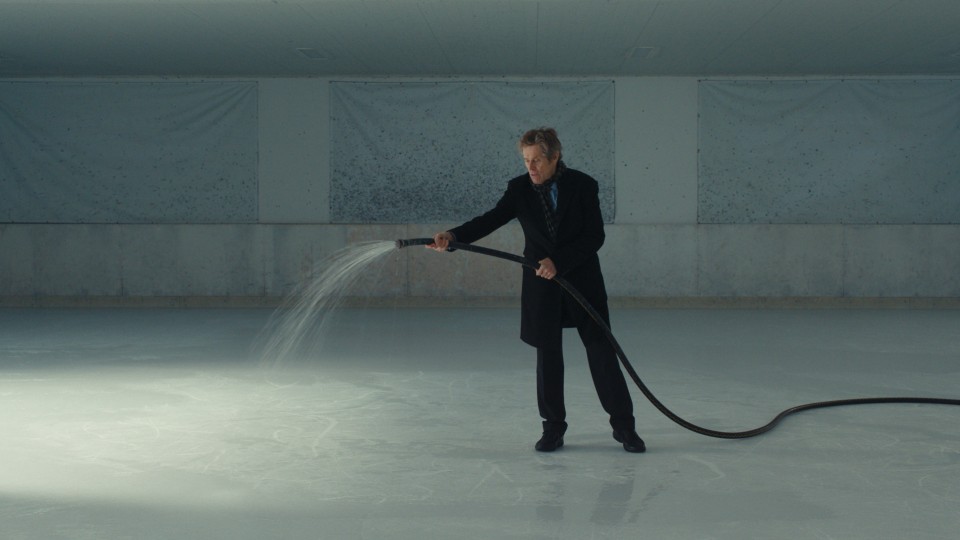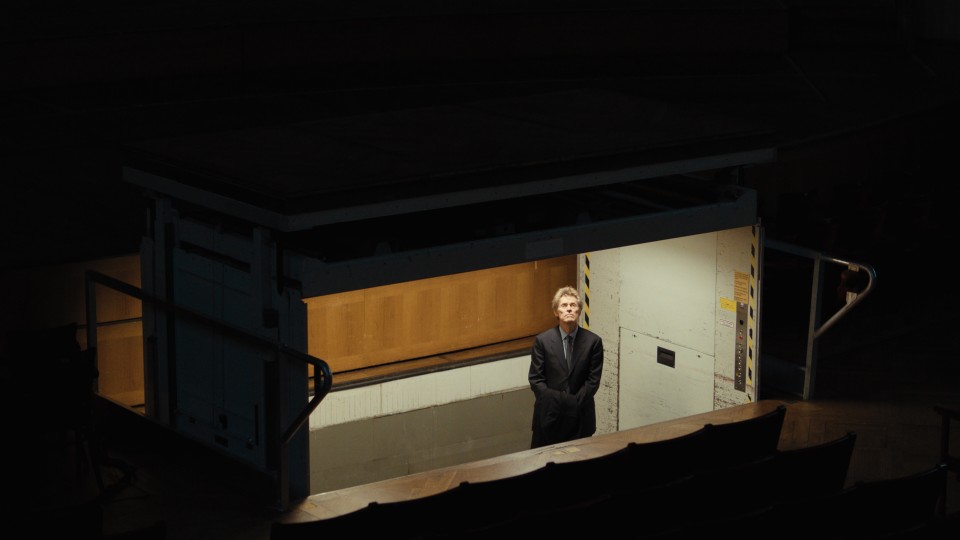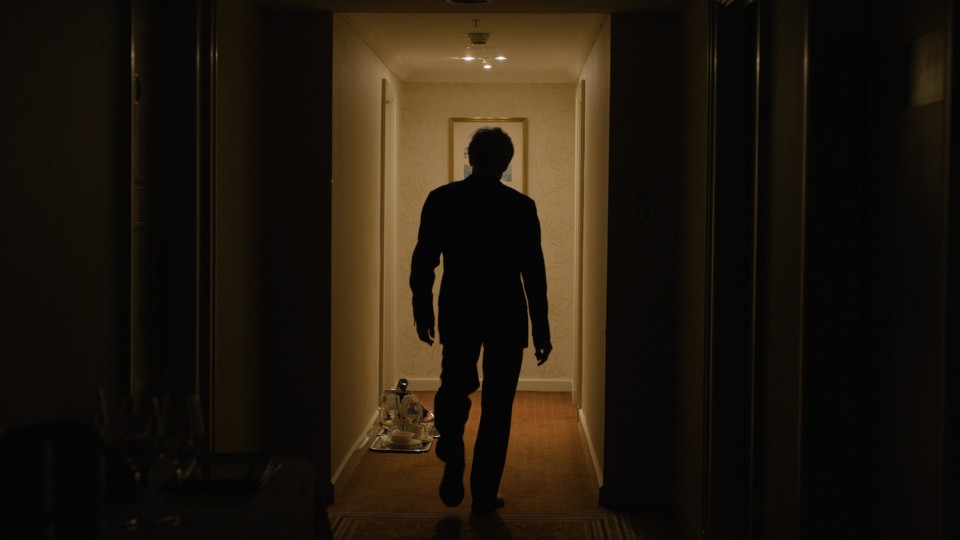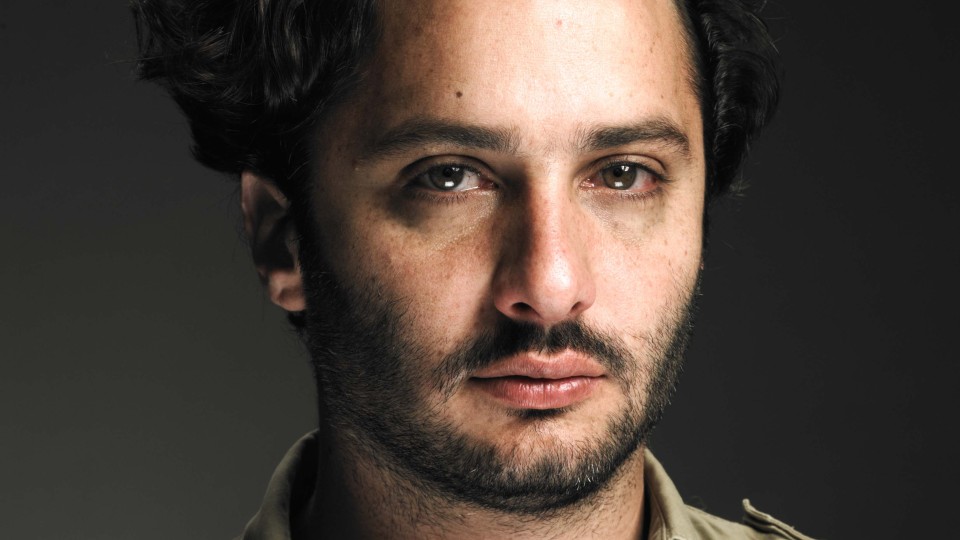The radiance of this Viennese hotel in such a prominent location is fading. Lucius Glanz, the manager, stubbornly attempts
to resist the march of time, but there’s no stopping the sale of the post-war jewel. THE SOUFFLEUR marks the completion of Gastón Solnicki‘s essayistic Viennese trilogy on transience, as he pays homage to the Hotel Intercontinental
and finds in Willem Dafoe a magnetic helmsman for a sinking ship.
THE SOUFFLEUR is the closing part of your Viennese trilogy. The memory of Hans Hurch inspired Introduzione all'Oscuro, the
smoking ban in Viennese coffee houses A Little Love Package – time passing by and nostalgia being a central motif of all your
films. Was it the debate about the demolition of the Vienna Hotel Intercontinental that prompted you to write a third part?
GASTÓN SOLNICKI: There’s nothing linear either in my film or in the trilogy. There’s my relation to Vienna, and also to the Hotel Intercontinental.
I’m very curious how the films of the trilogy will stand time, even in a city that seems not so affected by time, how this
work will grow and change. My DoP Rui Poças, who shot all three parts, and me, we’re very often asked about our relation to
Vienna. It always makes us laugh; it’s just evident, there’s not one particular reason that brought us back to Vienna to make
this third film. As you can see in the archives, I was in Vienna as a very young boy. The era of hotels such as the Hotel
Intercontinental built in the 1960s represented a very new concept of tourism, this kind of hotel is connected to a very specific
era. THE SOUFFLEUR is also related to Billy Wilder who is referenced in the film, and to Eins, zwei, drei which I saw on the
occasion of an homage to Eric Pleskow on whom the protagonist was inspired. I was very much drawn by this atmosphere of the
East-West tension and this specific moment of the postwar comedy when I started thinking of the film. The pending demolition
of the Hotel Intercontinental was not something I was very much concerned about. This is my sixth feature film, and the more
I try to develop on script and to raise the ceiling of a certain aspect of my work that has a lot to do with spontaneity and
improvisation, the more I learn to be suspicious of subjects and certain ideas of material. For me that’s just material to
work around, and at some point through them – this might sound a bit Buddhist – I access emotion. There’s always an emotion
in the end that I couldn’t have foreseen in the beginning. Even with the hotel. Hotels, like cinemas, are windows to the world,
there are a lot of interesting clichés, and somehow the hotel is just an opening to the film, to Vienna and also to connect
with the main character Lucius Glanz, who, like myself, is not from the city, but strongly connected to it, and we follow
in the film his fight to preserve an aspect of a world that he feels is fading away.
If your driving force is more emotion than subjects, how do you let yourself go in the writing process, once you are sure
about the emotions you’d like to touch?
GASTÓN SOLNICKI: Writing is a clumsy process. I trained at film school, or at least attempted to, and I’m still in contact with my mentors.
One thing is for sure; my scripts are not structured in A, B, C, D
, that’s not the force of my work. But there’s a capacity,
not only for textures but also for a certain tenderness to which I’m often drawn in Vienna – it can be the non-professional
actors, it can be places or the architecture. There’s a lot of things that resonate with me. It’s a difficult process, since
it is very intuitive, and it’s very hard to elaborate on that in a written form of a script. That’s why it is difficult for
me to work with screenwriters, and for sure, it’s difficult for them to work with me. I’m still trying. And it’s a fertile
quest. THE SOUFFLEUR has more of a main character, of a conflict, of a story even though it still remains very open to the
dissonances and digressions that I am personally attracted to. I can’t help it. On my way to follow narrative strategies I
feel very attracted to other things. And there’s also the challenge of time. There was very little time. Working with Willem
Dafoe made it much more challenging while also opening a totally new dimension to my work. He was so generous and involved,
and once you have such a strong personality on board, everything starts to circulate like in an orbit. He changed everything.
For me, it meant to leave my register, and also for Willem it was an interesting challenge.
At which moment did Willem Defoe become your main actor?
GASTÓN SOLNICKI: It’s not my thing to have an elaborate idea beforehand, it often starts with the people involved, with the places. I met
Willem at a Screenwriting Lab called Oxbelly where he started to be interested. I was surprised how nice and open he was.
He asked me for the links of my films and wrote me a very long feedback. It was the beginning of a friendship. I understood
that bringing him on board also exposed me to different possibilities, not only financially speaking. By bringing Willem,
who represents a sort of archetype of fiction, into my world of non-actors and real locations in Vienna, it became a very
strange film to make. The opposition of forces with a very established Hollywood actor, and a film that is scripted in the
form I mentioned before and a very small budget, made the strange quality of the film, a rare animal.
How did Willem Dafoe’s Hollywood energy fit in your very unusual context of shooting?
GASTÓN SOLNICKI: I used to have more hair before the shooting and looked younger
Willem is an incredible actor and person. Very brave. During
the editing process, I realized how much he himself was exposed. Actors have to find their way to bite into their character.
I was not used to working with anybody like him. It was very tense to shoot at a functioning hotel. But, despite the physical
and emotional torture, the film is there. I’m happy that in the end the international aspect of Austria manages to resonate
with some autobiographical elements of me coming from Argentina. Willem asked me to play in the film. I didn’t want to make
it more difficult. If the game was to work with non-actors, and Willem wanted me there, I thought it would be more honest
not to just frame them and be one of them. It was a complex process, and it was only in the editing that the film came to
life.
The narrative of THE SOUFFLEUR is dominated by the impending sale of the hotel and the hotel manager's attempts to save it.
But there are also documentary elements in the film. You immersed yourself in the hotel's history and found archive material
from the 1960s and also from the adjacent Vienna Skating Club. Where did you find this material?
GASTÓN SOLNICKI: We found beautiful archives from ORF and media wien. They were important to bring emotion. Often my subjects can be considered
more of a niche, difficult to connect with. When you find a certain emotional bridge for the audience, that’s a key moment.
There’s no recipe for this kind of bond. The images of the groundbreaking of the hotel were one of the most important discoveries
of the development stage. I was surprised to find out that this event had enough political relevance that it was filmed. I
wanted to use this material for the opening. During the editing process we started to look for more archive and received beautiful
scans from ORF, and we worked on sound elements of that era to recreate this atmosphere. What was very touching for me, were
the images from the seventies with those kids playing without phones on the ice-skating rink – this starts to resonate with
a world I lived in as a child; I remember the clothes of this time, the irreverence of the youth. Even current teenagers who
didn’t experience this period recognize with emotion a time that is gone, which Lucius Glanz is trying to defend in the film.
It’s not only beautiful; it brought a specific emotion and meaning to the film which, once again, was not designed beforehand.
More than your previous films, THE SOUFFLEUR is both a fiction and a documentary.
GASTÓN SOLNICKI: Of course. As cinema always has been. This is for me the most interesting aspect of this Viennese trilogy. Introduzione all’Oscuro
was also fiction, documentary and essay, sometimes at once, and this is a great capacity of cinema, that’s something I intend
to work on, not to draw more lines, but to get rid of them.
We already see takes from the hotel towards the ice rink in Introduzione all'Oscuro. Does the image of the ice rink have a
significance as a place of fragility, of foundations shifting and risks of falling?
GASTÓN SOLNICKI: I totally identify with that. I don’t put images to convey a certain meaning; it’s always intuitive. But ice is slippery,
watery, ethereal, and there’s also the idea of something arid and infertile. Lucius is dreaming of raising alpacas in the
countryside and starting a garden. And his daily gesture in the city, as a kind of therapeutical act, is to throw water on
a cold electrical surface where nothing grows but still people can use the surface of the ice rink for joy and recreation.
The hotel was built next to the ice rink of the Vienna Skating Club, which during the shooting was very helpful as an open
space, with its own history, as a location where you can track the history of the city back in time. We found little gems
in the archives. I like to use them this way; they add images that already existed, and by making a film you create new archives.
That’s a beautiful conversation that has been present in cinema from the beginning.
A very funny and meaningful moment occurs at the beginning when Lucius lies on the hotel kitchen cupboard and tries to repair
the broken wall clock.
What kind of humor did you want to convey in this story?
GASTÓN SOLNICKI: I’m glad you like this moment. It was one of the gags that had more development in the script – the man with the clock, the
man and the machine. I can’t think about different kinds of humor. Humor is not something to be learned; it’s instinctive.
With Willem, we had a lot of fun together; there were actually a lot of parallels with Hans, not just that they were together
the night he died in Rome. When I spend time with Willem I feel the same odd feeling of fortune, why would somebody so clever
and so funny who has so many things to do, choose to spend time with me, walk around in a park, looking at silly things, talking
about personal things. I mean it, it’s the same feeling. My film is centered around humor and tenderness. People may have
strange ideas about film stars, but that’s what you’re impressed about with Willem. People were surprised that he is such
an open person, he connects easily with people. We create those icons, idols and forget that they’re also persons. With Willem
the whole thing was developed for years. He always insisted that I do things how I’m used to do it, very spontaneously. We
tried to do the best with what we had. Slapstick and the grotesque, that’s something that I don’t choose; it’s just there
all the time.
You didn’t have much time to shoot. It seems that you were able to shoot at the actual location, the genuine Hotel Intercontinental
in Vienna. How did this work?
GASTÓN SOLNICKI: That was a question we had to face in the beginning. We scouted a whole lot of hotels in Vienna, but I have difficulties
with this logic. Cinema is often constructed in that way. As architecture and places play such an important role in my films,
I’d rather change the whole film than shoot it in another hotel. The Hotel Intercontinental is a central character from the
basement to the roof, the dishes, the oven, the people who have worked there for a long time, their dynamics, the lights,
the archives: everything is a living organism. Of course it was difficult, because the hotel was functioning, they didn’t
want us to bother the guests and we had very limited access to shoot. We managed to shoot there at a great compromise. It
was a nightmare in terms of logistics, and with Willem – who attracted called a lot of attention - it was a very tricky challenge.
I’m grateful to the Austrian institutions that supported us in a world where it is harder and harder to finance a film. I
live in a country where art and culture are currently attacked by the government. In a time like this we should not take our
institutions for granted. I feel generously supported.
How did you compose your cast around Willem Defoe?
GASTÓN SOLNICKI: Willem was the center; he wanted me to play the character of Facundo Ordoñez. Claus Philipp was one of the writers with whom
I developed the project in the beginning; he brought a lot of humor to the film. There are people from the hotel, who I’ve
known for all the years I’ve attended the Viennale, there’s the wonderful Lilly Lindner, who I met during the pandemic when
we were shooting A Little Love Package with Anton Sutterlüty, the famous cheesemaker. I thought that Lilly could be the right
person for the character of Lucius Glanz’s daughter. When we started working, she immediately opened herself in such a remarkable
way. I would often see Willem crying after the shooting of the scenes, he was so touched by her. When you film a non-actor
you don’t expect him or her to be an incredible performer; they are working around something very real about themselves. Lilly
came with all her energy and generosity. During the editing process I made a test screening in Buenos Aires, and for the younger
viewers the film is about Lilly, since she is the one who has to deal with the weight of history and the way it impacts on
her. I also think that the film is very much about her. Then, there’s Han Gyeol Lie, my friend who plays the piano in all
my Viennese films as a real figure. Stephanie Argerich and I have been good friends since we were very young; we haven’t been
in contact for a long time, I thought she’d be good for this character. She’s not a pianist but learned this piece by Bach
and played it beautifully. It was very interesting to bring her into the mélange.
We haven’t talked yet about the title of the film and the symbolism of the soufflé that you show twice in the film, rising
in the oven of the hotel kitchen.
GASTÓN SOLNICKI: I like the idea of something fragile that somehow grows and then immediately collapses. I like the idea of the soufflé, and
the moment I learned that “Souffleur” meant theatre prompter, that was a real epiphany. The film is an homage to theatre,
to Willem as a stage actor and to the element of manipulation that also concerns my work as a filmmaker, since you always
have to ask people to do things in a certain way. I like the semantic layers of the term and the idea that the theatre prompter,
as well as the page turner at a concert, can destroy someone’s performance by messing up. These are ideas which serve us to
move in a direction when we’re making the film and then have to get rid of at a certain point. “The souffleur” stayed there
as a metaphor, as an image representing a theatre prompter or a cheese soufflé. I think it is a good title. A title also becomes
a very meaningful force to keep things tight and together. And I like the parallel: anyone who has attempted to make a soufflé
knows that it can easily go wrong.
Interview: Karin Schiefer
September 2025






